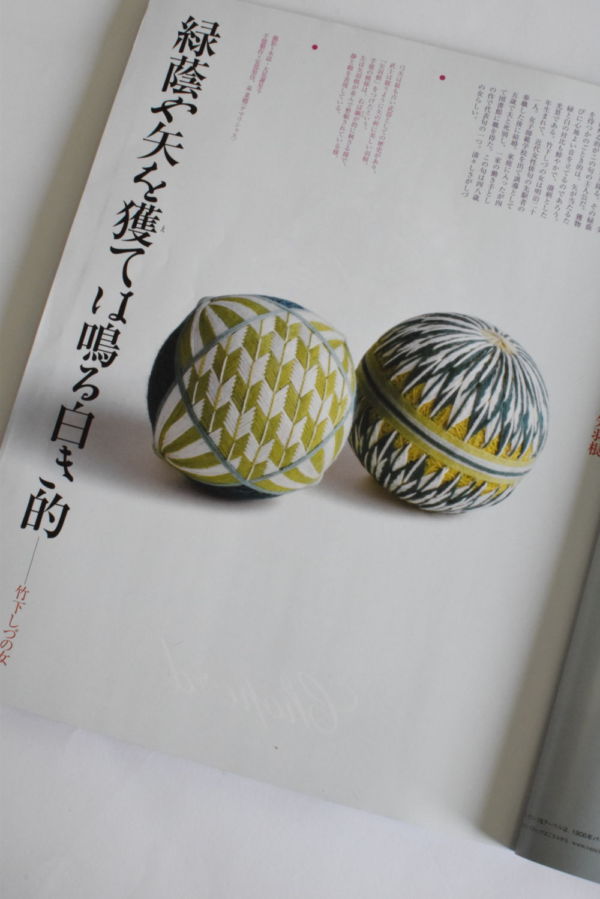This is TEMARICIOUS past blog archive written by Rika.
2019.06.13
The July issue of Kateigaho has been released.
``Prayer-filled Temari History'' has already reached its 7th edition. I am always surprised by the haiku that haiku master Masako Yamanishi chooses.
I often get asked this question, which comes first: haiku or temari? That's what it means.
In conclusion, simultaneous progress!
The theme of the Temari Calendar is chosen by the editors with careful consideration of both haiku and temari.
Create an image of the pattern and color of the temari within the theme. If you wait for a haiku, you may not have time to create it in time. As I was doing this, a haiku was selected and delivered to me.
So, with this haiku, I think it would be possible to link it to Temari! After choosing and reporting to you, the editor looks at the balance and makes a final decision, and the haiku is decided.
But it's not the same every time, and sometimes we create our own hidden themes and start making them.
There have been many times when a temari is interesting, but it's scary how perfectly the haiku fits the theme, and it's like a heart-to-heart connection with Mr. Yamanishi.
household pictorial
Temari Calendar with Prayers – July fletching
A white target rings out when it captures the green shade and the arrow.
Takeshita Zuno's woman
What a refreshing haiku!
First, the video begins in green shade.
Is this a picture of someone resting in the shade of a tree to avoid the heat and looking up?
I imagined the linden tree when I rested in the Baltic countries.

And the white target is the main character.
The color changes from green to white.
The expression of the white target catching the arrow seems natural, but I don't think it would happen naturally.
The image of an arrow hitting a white target and making a pleasant sound comes to mind.
There was no feeling of being irritated by the heat, just the cool green leaves, the cool breeze, the speed of the arrow, and the refreshing white target.
This haiku blows my mind.
In order to create a temari as good as this haiku, I used plenty of Temaricious's special green.
Dyeing green with plants is quite difficult.
I used to think that I could easily make green leaves by dyeing them green, but I was wrong.
The green is made by combining the blue of indigo and the yellow of onions, fukuki, and halcyon.
The depth of the green changes due to subtle differences in the amounts of indigo and yellow materials.
The very refreshing yellow-green and deep blue-green are both really popular colors in Temaricious, and are one of the colors that disappear no matter how many times you dye them.
And arrow feathers.
I made two types of temari: an arrow feather made by making chrysanthemums and adding a few lines, and an arrow feather made to look like textiles.
The method of making it is completely different.
The cameraman understood Temaricious's Temari very well,
They described the temari we made as ``stillness and movement.''
I thought that was exactly the case, and I fell in love with these two Temari even more.
The arrow feathers are a simple pattern, but very beautiful. I thought that the beauty of that pattern was common all over the world, but I was surprised to see that the strings at the booths of artists who were researching how to make traditional crafts at the Latvian Forest Folk Art Fair the other day were arrow feathers.
A feather is the feather of an eagle, hawk, or kite that is attached to the top of an arrow. Bows and arrows are one of the oldest weapons, used for men's celebratory events, and the beauty of the weapons was probably competed.
It is an auspicious pattern with words such as ``Hamaya'', meaning to ward off evil spirits, or ``hitting the target''.
The beautiful design of arrow feathers is a kimono pattern that can still be seen today. It is a pattern that has blended into the world of fashion.
During the Edo period, it was said that if a person gets married in a kimono made of arrow kasuri, it will not come back (because the arrows shot will not return), and it was considered a lucky charm. The combination of a shrimp-brown hakama was called the ``shrimp tea ceremony'' and became very popular among female students.
Personally, I'm drawn to the beauty of arrow feathers because they were attached to the first weapon.
The arrow flies straight and catches the prey. This is because we can feel the original high aesthetic sense of humans in the beauty and design that took place in an era when people were closely connected to life.
Well, this is getting long.
The July issue of Kateigaho is currently in the middle of the rainy season in Japan.
Even during the rainy season, enjoy the refreshing greenery of Temaricious that will brighten your heart.
I'm looking forward to seeing you next month.






